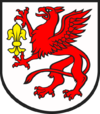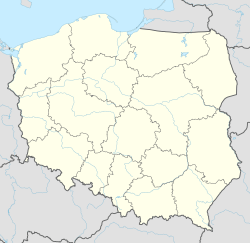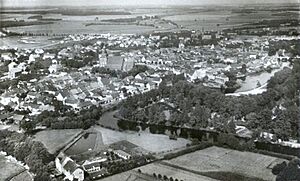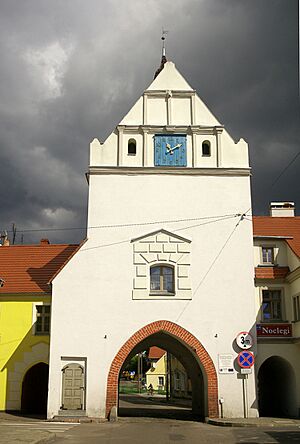Gryfice facts for kids
Quick facts for kids
Gryfice
|
|||
|---|---|---|---|
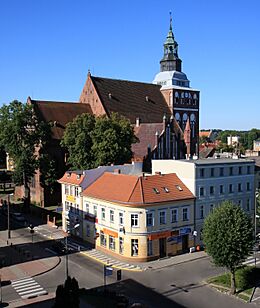
Victory Square and Saint Mary's Church
|
|||
|
|||
| Country | |||
| Voivodeship | |||
| County | Gryfice | ||
| Gmina | Gryfice | ||
| City rights | 1262 | ||
| Area | |||
| • Total | 12.4 km2 (4.8 sq mi) | ||
| Population
(2017)
|
|||
| • Total | 16,600 | ||
| • Density | 1,339/km2 (3,467/sq mi) | ||
| Time zone | UTC+1 (CET) | ||
| • Summer (DST) | UTC+2 (CEST) | ||
| Postal code |
72-300
|
||
| Car plates | ZGY | ||
| Website | http://www.urzad.gryfice.eu/ | ||
Gryfice (pronounced Gri-fitse) is a historic town in northwestern Poland. It has about 16,600 people (as of 2017). Gryfice is the main town of Gryfice County. It is located in the West Pomeranian Voivodeship. The town is about 22 kilometers (14 miles) from the Baltic Sea coast.
Contents
History of Gryfice
Early Times
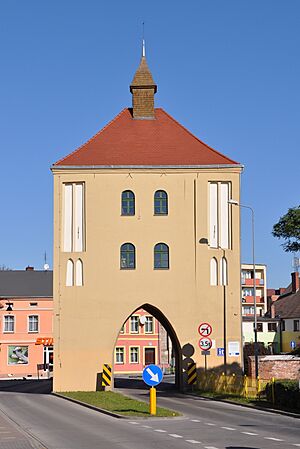
The area where Gryfice is located was part of Poland a long time ago. This was during the rule of the first Polish leader, Mieszko I. It was also part of Poland during the early rule of Bolesław I the Brave. Around 1005, the region broke away from Poland. But it was taken back by the Polish king in the early 1100s.
A big battle, called the Battle of Niekładź, happened near Gryfice in 1121. In this battle, Polish ruler Bolesław III Wrymouth won against the Dukes of Pomerania. The area then became part of the Duchy of Pomerania. This duchy was connected to Poland. Later, it became separate from Poland.
In 1262, Wartislaw III, Duke of Pomerania started a new town. He used Lübeck law to attract German settlers. After he died, the next duke, Barnim I, Duke of Pomerania, named the town Civitat Griphemberch super Regam. This name means "Griffin's mountain" in old German. It was named after the griffin symbol on the dukes' coats of arms.
In 1365, Gryfice joined the Hanseatic League. This was a powerful group of trading cities. The town became rich because ships could freely travel on the Rega river. They even had a 350-year-long argument about using the river for transporting goods!
A strong town wall was built around Gryfice. At the end of the 1200s, people started building the St. Mary's church. A school that taught Latin was mentioned in a document from 1386. Many people think this was the oldest school in Pomerania.
Modern Times
In the 1500s, German people in the area tried to make everyone speak German. But this did not happen quickly. Some local farmers moved to Poland. At the same time, some people from Scotland came to live in Gryfice.
The Thirty Years' War caused the town's population to drop a lot. Armies from the Holy Roman Empire and Sweden took over the town. After the last duke of Pomerania died, Gryfice became part of Brandenburg-Prussia in 1648. This was decided by the Treaty of Westphalia. Later, in 1871, it became part of Imperial Germany. In 1818, Gryfice became the main town of the Greifenberg district.
In 1894, a railway line connected Gryfice to other towns. On July 1, 1896, a narrow-gauge railway opened. Today, this railway is a museum. In 1933, a Polish group for farm workers was started in Gryfice. Polish and Jewish people faced harsh treatment after the Nazis came to power in Germany in 1933. During World War II, people from Poland were forced to work in Gryfice.
At the end of World War II, on March 5, 1945, the Soviet Red Army took over the town. On March 8, Polish people entered Gryfice. About 40% of the town was destroyed. However, many old buildings were still standing or were rebuilt. After the war, the town became part of Poland. It was first called Zagórze, but then its name was changed to Gryfice.
Many German people who did not leave during the war were later moved away. Polish people came to live in Gryfice. Some of these Polish people had also been forced to leave their homes in other parts of Poland. The first local government in Gryfice after the war was set up with the help of Polish people who had been forced laborers.
After the war, the town started to rebuild. In 1945, the first schools, a hospital, and a cinema opened. The next year, a mill, a gasworks, and a jam factory opened. In 1948, a sugar factory was built. By 1951, it was one of the best sugar factories in Poland.
Population Changes
Between its founding and 1945, most people in Gryfice spoke German. By the 1700s, almost everyone was a Lutheran Protestant. There were also small groups of Jewish and Catholic people. After World War II, most German people moved away. Polish settlers then moved into the empty buildings. Because of this, most people in Gryfice today are Roman Catholics.
| Year | Inhabitants | Notes |
|---|---|---|
| 1740 | 1,724 | |
| 1782 | 1,890 | incl. 20 Jews. |
| 1794 | 2,138 | incl. 19 Jews. |
| 1812 | 2,445 | incl. 15 Catholics and 35 Jews. |
| 1816 | 2,610 | incl. 44 Catholics and 35 Jews. |
| 1831 | 3,272 | incl. 13 Catholics and 82 Jews. |
| 1843 | 4,027 | incl. 9 Catholics and 132 Jews. |
| 1852 | 4,886 | incl. 15 Catholics and 129 Jews. |
| 1861 | 5,361 | incl. 31 Catholics, and 134 Jews. |
| 1900 | 6,477 | |
| 1925 | 8,370 | incl. 110 Catholics, 80 Jews and 630 others. |
| 1939 | 10,800 | |
| 1946 | 4,900 | after expulsion of Germans after World War II and war losses |
| 1950 | 8,700 | |
| 1960 | 11,600 | |
| 1970 | 13,200 | |
| 1980 | 15,300 | |
| 1990 | 17,600 | |
| 2000 | 17,300 |
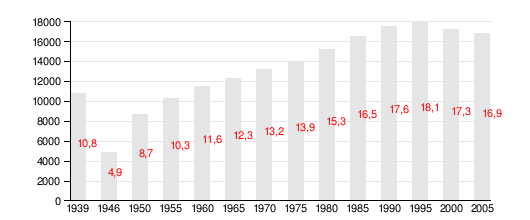
Famous People from Gryfice
Many interesting people have come from Gryfice, including:
- David Christiani (1610–1688), a German mathematician and philosopher.
- Karl Wilhelm Gottlob Kastner (1783–1857), a German chemist and professor.
- Gustav von Struensee (1803–1875), a German writer.
- Herman Schatz (1843–1906), an American politician who moved to the US in 1851.
- Friedrich Heinrich Albert Wangerin (1844–1933), a German mathematician.
- Richard C. H. Lenski (1864−1936), a Lutheran scholar who moved to the US in 1872.
- Conrad Pochhammer (1873–1932), a German doctor and surgeon.
- Rita von Gaudecker (1879–1968), a German author of children's books.
- Moritz Seeler (1896–1942), a German poet, writer, and film producer.
- Ehrengard Schramm (1900–1985), a German politician and writer.
- Krzysztof Linkowski (born 1949), a retired Polish runner.
- Bartosz Nowicki (born 1984), a Polish middle-distance runner.
- Grzegorz Krychowiak (born 1990), a Polish professional football player.
Sister Cities
Gryfice is connected with other towns around the world. These are called "twin towns" or "sister cities." They work together to share culture and ideas.
 Güstrow, Germany
Güstrow, Germany Meldorf, Germany
Meldorf, Germany Gryfów Śląski, Poland
Gryfów Śląski, Poland
Images for kids



